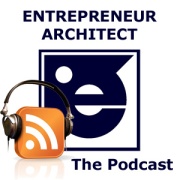Podcasts (an episodic digital series of audio or video files subscribed to and downloaded through web syndication or streamed online to a computer or mobile device) are a great way to learn the lessons about business that many of us lacked during architecture school.
Below are my 5 current favorites:
EntreLeadership | Dave Ramsey w/ Host Chris LoCurto
One of the most successful podcasts on the planet, EntreLeadership focuses on personal success, business and leadership. For about 45 minutes every two weeks, host Chris LoCurto guides us through a fundamental business topic such as Sales, Marketing, Delegation or Personal Productivity.
During each episode, LoCurto shares a lesson presented by Dave Ramsey recorded at one of his many live events. The second half of each show features LoCurto interviewing one of the nation’s top leaders or business people, such as Tony Dungy, Steven M. R. Covey, John Maxwell and Tony Hseih. Each interview dives deeply into the topic of the week and listeners learn many secrets to success.
For a little podcast bonus time, be sure to pop over to Chris’ own website for an extended interview with each guest.
The Rise to the Top | David Siteman Garland
A fun, inspirational and sometimes “off the wall” podcast about helping rising mediapreneurs (online media creators, authors, thought leaders, personal brands, coaches and internet marketers) grow their businesses and dominate online.
David’s in-depth interviews attack each subject with focus and dedication to finding the root of each entrepreneur’s success. As David states at the end of each recording, “if you’re looking for fluff, go pet a bunny”.
This is Your Life | Michael Hyatt
The former Chairman and CEO of Thomas Nelson Publishers, Michael Hyatt is now a consultant, speaker and author of the bestselling book, Platform: Get Noticed in a Noisy World.
Michael’s blog and accompanying podcast focuses on what he calls, “intentional leadership”. His mission is to help his listeners live with more passion, work with greater focus and lead with extraordinary influence. Sounds like a few things every Entrepreneur Architect is seeking, doesn’t it?
Startup School | Seth Godin
Marketing expert, top blogger, bestselling author, entrepreneur. Now he’s a podcaster too? Seth Godin shares recordings from his recent Startup School live seminar using the podcast format. He takes us from defining your approach to business (freelancer or entrepreneur?) all the way through startup launch in this weekly podcast.
Currently offering his 8th episode, when Godin reaches the end of the recorded event, will this become a permanent offering from Godin? Only time will tell.
This one is well worth the time while its still available.
Mixergy | Andrew Warner
A successful entrepreneur himself, Andrew Warner spends an hour each week interviewing founders and CEOs of the world’s leading technology companies.
Focusing on the “ambitious upstart”, his questions probe deeply into the hows and whys of each entrepreneur’s story, teaching listeners what do to, as well as what not to do when launching and running a company.
So, what are some of your favorite podcasts? Please share a link in the comments so everyone may check them out.
photo credit: Colleen AF Venable via photopin cc

 From OptimaWeb.com:
From OptimaWeb.com:





